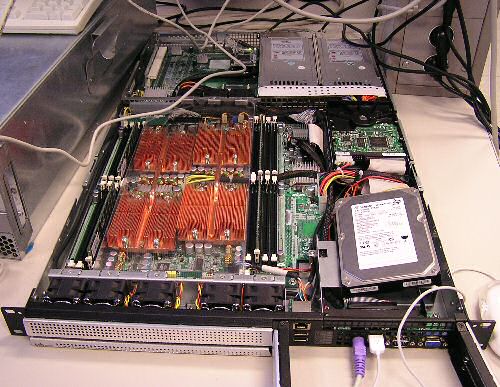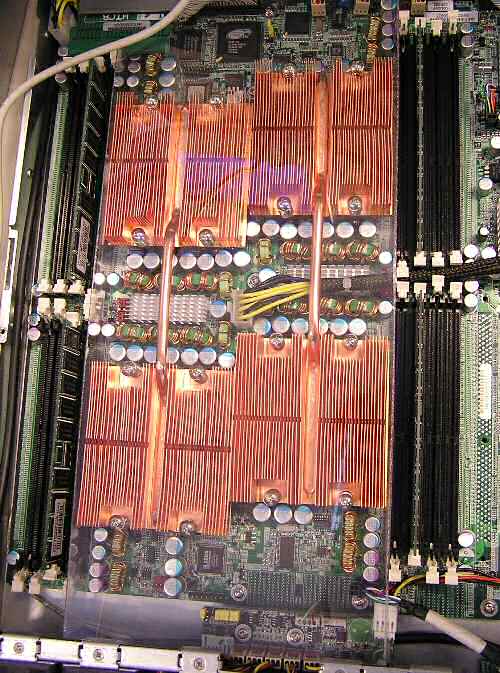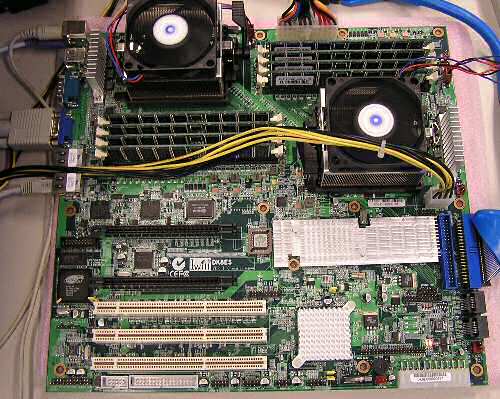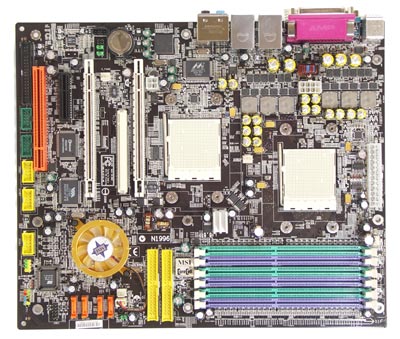Linux Database Server CPU Comparison
by Johan De Gelas on June 17, 2005 12:05 AM EST- Posted in
- IT Computing
Words of thanks
A lot of people gave us assistance with this project, and we like to thank them of course:David Van Dromme, Iwill Benelux Helpdesk (http://www.iwill-benelux.com)
Ilona van Poppel, MSI Netherlands (http://www.msi-computer.nl)
Frank Balzer, IBM DB2/SUSE Linux Expert
Jasmin Ul-Haque, Novell Corporate Communications - SUSE LINUX
Matty Bakkeren, Intel Netherlands
Trevor E. Lawless, Intel US
Larry.D. Gray, Intel US
Markus Weingartner, Intel Germany
Nick Leman, MySQL expert
Bert Van Petegem, DB2 Expert
Ruben Demuynck, Vtune and OS X expert
Yves Van Steen, developer Dbconn
Damon Muzny, AMD US
I would also like to thank Lode De Geyter, Manager of the PIH, for letting us use the infrastructure of the Technical University of Kortrijk in which to test the database servers.
Benchmark configuration
To ensure that our databases were stable and reliable, we followed the guidelines of SUSE and IBM. For example, DB2 is only certified to run on the SLES versions of SUSE Linux - you cannot run it - in theory - on any Linux distribution. We also used the MySQL version (4.0.18) that came with the SUSE SLES9 CD's, which was certified to work on our OS.Network performance wasn't an issue. We used a direct Gigabit Ethernet link between client and server. On average, the server received 4 Mbit/s and sent 19 Mbit/s of data, with a peak of 140 Mbit/s, way below the limits of Gigabit. The disk system wasn't overly challenged either: up to 600 KB of reads and at most 23 KB/s writes. You can read more about our MySQL and DB2 test methods.
Software:
IBM DB2 Enterprise Server Edition 8.2 (DB2ESE), 32 bit and 64 bitMySQL 4.0.18, 32 en 64 bit, MyISAM and InnoDB engine SUSE SLES 9 (SUSE Entreprise Edition) , Linux kernel 2.6.5, 64 bit.
Hardware
We'll discuss the different servers that we tested in more detail below. Here is the list of the different configurations:Intel Server 1:
Dual Intel Nocona 3.6 GHz 1 MB L2-cache, 800 MHz FSB - Lindenhurst Chipset
Dual Intel Irwindale 3.6 GHz 2 MB L2-cache, 800 MHz FSB - Lindenhurst Chipset
Intel® Server Board SE7520AF2
8 GB (8x1024 MB) Micron Registered DDR-II PC2-3200R, 400 MHz CAS 3, ECC enabled
NIC: Dual Intel® PRO/1000 Server NIC (Intel® 82546GB controller)
Intel Server 2:
Dual Xeon DP 3.06 GHz 1 MB L3-cache, Dual Xeon 3.2 GHz 2MB L3-cache
Dual Xeon 3.2 GHz
Intel SE7505VB2 board - Dual DDR266
2 GB (4x512 MB) Crucial PC2100R - 250033R, 266 MHz CAS 2.5 (2.5-3-3-6)
NIC: 1 Gb Intel RC82540EM - Intel E1000 driver.
Intel Server 3:
Pentium-D EE 840
Intel SE7505VB2 board - Dual DDR266
2 GB (4x512 MB) Crucial PC2100R - 250033R, 266 MHz CAS 2.5 (2.5-3-3-6)
NIC: 1 Gb Intel RC82540EM - Intel E1000 driver.
Opteron Server 1: Dual Core Opteron 875 (2.2 GHz), Dual/ Single Opteron 850, Dual/Single Opteron 848
Iwill DK8ES Bios version 1.20
4 GB: 4x1GB MB Transcend (Hynix 503A) DDR400 - (3-3-3-6)
NIC: Broadcom BCM5721 (PCI-E)
Quad Opteron Server 2: Iwill H4103: Quad Opteron 844, 848
Iwill H4103
4-8 GB: 4-8x1GB MB Transcend (Hynix 503A) DDR400 - (3-3-3-6)
NIC: Intel 82546EB (PCI-E)
Opteron Server 3: Dual Core Opteron 875 (2.2 GHz), Dual/ Single Opteron 848
MSI K8N Master2-FAR
4 GB: 4x1GB MB Transcend (Hynix 503A) DDR400 - (3-3-3-6)
NIC: Broadcom BCM5721 (PCI-E)
Opteron Server 4: AMD Quartet: Dual Opteron 848, Quad 848
Quartet motherboard, Zildjian personality board, Tobias backplane board and Rivera power distribution board.
Quad configurations: 4 GB: 8x512 MB infineon PC2700 Registered, ECC enabled
Dual configurations: 2 GB: 4x512 MB infineon PC2700 Registered, ECC enabled
NIC: Broadcom NetExtreme Gigabit
Client Configuration: Dual Opteron 850
MSI K8T Master1-FAR
4x512 MB infineon PC2700 Registered, ECC enabled
NIC: Broadcom 5705
Shared Components
1 Seagate Cheetah 36 GB - 15000 RPM - 320 MB/s
Maxtor 120 GB DiamondMax Plus 9 (7200 RPM, ATA-100/133, 8 MB cache)
Software
Vtune for Windows version 7.2, Vtune for Linux remote agent 3.0Code Analyst for Linux 3.4.8
Code Analyst for Windows 2.3.4
More about the servers in this test
Although our main focus is the database server performance of the different AMD and Intel platforms, allow me to introduce some of the motherboards and server barebones that we used in this test.Iwill H4103
The amount of power that the Iwill H4103 can pack in a 1U rack mounted case is nothing short of amazing. As you can see, there are no less than 4 Opterons in this pizza box, which also allows you to put up to 32 GB of DDR RAM in there. Even more impressive is the inclusion of two redundant 700 Watt power supplies.


What about cooling? Well, this is a server of course and a whole battery of 10,000 RPM fans keep the copper heat sinks cool. In our poorly cooled lab, temperatures rose easily to 30°C and higher, but the Iwill H4103 heat sinks hardly became warm under full load. According to Iwill, you should be able to use dual core Opterons in this pizza box, but we haven't been able to verify this as the necessary BIOS version still had yet to arrive.
The H4103 left a very stable and highly performing impression upon us. The only thing left that would make this ultra compact quad Opteron machine complete is the integration of a SCSI controller or at least a very good SATA controller.
Iwill DK8ES
The Iwill DK8ES is a server board, based on NVIDIA's nForce 4 2200 Professional chipset, which includes two x16 PCI Express slots. The board also integrates an ATI RageXL VGA controller, 2 x PCI-Express x16 expansion slots (one in PCI-Express x2 mode), 3 PCI-X 64bit 133/100/66MHz expansion slots and 4 SATA ports. Two Broadcom BCM5721PCI-E Gigabit Ethernet Controllers are connected to a PCI-E port.

The board has proven to be fully stable during 6 weeks of heavy database server testing. The only problem was that Linux didn't like running Dual core Opterons on this board. A BIOS update (to 1.20) made the Opteron 275 and 875 run stable on this board, but Linux (kernel 2.6.12) still didn't use both cores. Both cores were reported, but only one was used. We suspect that Iwill may have to work out a BIOS issue, or that some of the NVIDIA Linux drivers still need some tuning.
MSI's K8Master-FAR2
MSI sent us a completely different, relatively cheap workstation board that should enable very compact quad core (two dual cores) Opteron machines. The MSI K8Master-Far2 is based on the NVIDIA nForce 4 Pro chipset.In order to get two Opteron sockets, one 32-bit/33 MHz PCI slot, one PCI Express x4 slot and two PCI Express x16 slots (SLI mode supported) on a standard ATX board, MSI didn't give the second CPU local memory. Despite this limitation, the MSI K8Master-FAR2 proved to be an excellent performer in our database server tests.
Six memory slots allow up to 12 GB of RAM, not bad for such a compact board.

But at the end of the tests, the MSI K8Master-FAR2 (BIOS version 1.0) proved to be a very capable board. Supported by our Vantec 470W power supply, it had no trouble at all with two 875 Opterons running heavy database server tests for more than 3 weeks.










45 Comments
View All Comments
erwos - Friday, June 17, 2005 - link
If they used RHEL4, this would be far more useful. SuSE's not quite a bit player, but let's face it: Red Hat is dominating the commercial space.-Erwos
SunLord - Friday, June 17, 2005 - link
Interesting benchmark though i would of prefered you used a postgresql instead of DB2 since it's also open source and is the most likely alternnative to mysql... a DB2/Oracle bench would be kinda cool...Son of a N00b - Friday, June 17, 2005 - link
nice work guys!nserra - Friday, June 17, 2005 - link
#6 "but very important: AMD, OPEN YOUR EYES AND SEE WHAT INTEL IS DOING WITH PRICING ON DUAL CORES! don't get cought with pants down."Explain me something:
- how do you explain or how Intel will explain that their single core processor cost more than the dual core ones?
- Why should you buy a single core over a dual core if it cost more?
- How good is this Intel market decision (marketing).
I think is pretty logical to me that a dual core cost more than a single core processor so 4800+ more expansive than a 4000+ so it's OK! Stop blaming AMD, and their marketing team!
Viditor - Friday, June 17, 2005 - link
Calin - "Unfortunately, it seems that their dual core processors will be more expensive than Intel's"Actually, that's not true at all!
The fact is that AMD haven't released a "Value Line" of dual core yet because they don't see a large enough market for it.
By comparing the 2 companies offerings, it's apparent that the 820D should match up equvalently to a dual core Sempron when it's released, and the ($1000) 840EE matches up to the ($500) 4200+ rather nicely.
The 4400+ and the 4800+ are in a class by themselves without competition at the moment, hence the prices are high.
AlexWade - Friday, June 17, 2005 - link
I like these real world benchmarks articles.snedzad - Friday, June 17, 2005 - link
Again "Root me" wallpaper. Moron.Starglider - Friday, June 17, 2005 - link
I would guess that the problem is the netburst architecture's fast integer units. As I recall, the P4 integer units are split into two 16-bit stages and run at double the main clock using complicated differential signaling logic. I seriously doubt it would be feasible for Intel to add another two stages or to double the width of the units, as they're already power and chip area hungry and pretty much integral to the design. AMD on the other hand designed the Opteron to be 64-bit from the ground up and is running at a lower clock speed, making 64-bit wide single stage logic much easier.Thus the authors speculation that the P4 is taking twice as many cycles to process 64-bit simple integer operations (while the Opteron needs no additional cycles) seems highly likely to me. I'm one of those (apparently) rare programmers that needs to use 64-bit integers a lot, so it's not surprising that all our compute servers are Opteron powered.
Calin - Friday, June 17, 2005 - link
I really hope AMD will get a share of the higher profit server processor market. Unfortunately, it seems that their dual core processors will be more expensive than Intel'sZalmanKalman - Friday, June 17, 2005 - link
Wow, great and detailed artical. The punchline is so sweet to my ears. Vary sad to INTeL Fans, but I guess they buy, and will buy, intel b/c of corporate safty.but very important: AMD, OPEN YOUR EYES AND SEE WHAT INTEL IS DOING WITH PRICING ON DUAL CORES! don't get cought with pants down.